Comet PanSTARRS (C/2011 L4) peaked out at roughly magnitude +1 and is now fading with a very wide tail. We covered the comet in the February and March 2013 issues of Sky & Telescope. Here's the latest:
April 23: Crossing Cassiopeia. The comet is heading north, in Cassiopeia through the end of April. It's much better seen (from north temperate latitudes) before dawn now than after dusk. The comet has faded to about 6th magnitude, detectable in binoculars and very respectable in a telescope. Use the finder chart in the March Sky & Telescope, page 51.
Its tail has grown hugely wide! It's a fan spanning 160° in this photo of the comet passing the irregular galaxy IC 10, taken remotely by Rolando Ligustri on April 22nd.
April 10. It's moving farther north and fading on schedule, now 4th or 5th magnitude. Here are images from April 1 to 10 taken from the Orkney Islands, Scotland, by John C. Vetterlein of the Auroral & Magnetic Observatory in Rousay, latitude 59° north, where the comet is nicely circumpolar.
April 2. The comet passes the Andromeda Galaxy in the first week of April. They're closest (2° apart) on the evening of the 3rd and morning of the 4th. See article, Comet PanSTARRS Offers M31 Photo Op.
March 29. From Norway comes the gorgeous picture below, as PanSTARRS approaches the Andromeda Galaxy.
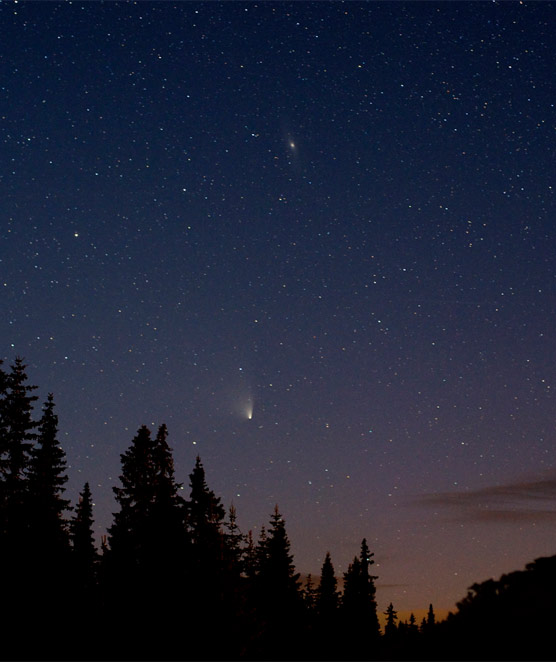
HÃ¥kon Dahle took this photo on the evening of March 28, 2013, from Skeikampen, Norway. Click for larger view and more information. H?•kon Dahle |
March 21. Last night Sean Walker, Sky & Telescope's imaging editor, took the shot below:
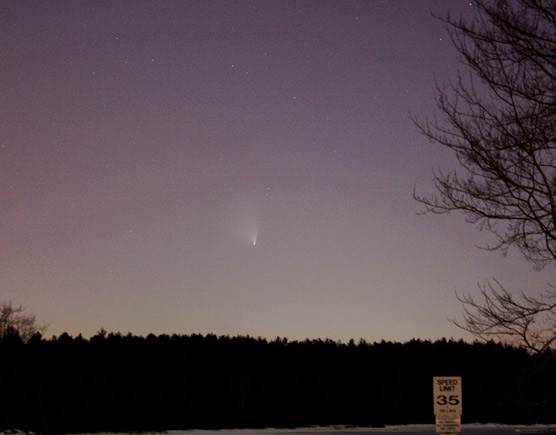
The comet and Earth are moving around to give us a more broadside view of the tail. All comet dust tails are flat, thin sheets confined to the comet's orbital plane. Sean Walker took this shot from 43° north latitude. S&T: Sean Walker |
Walker writes, "Tried some wide-field shots tonight. Should have brought a slightly longer lens! 18-55mm zoom lens at 55mm, ISO 800; 60-second exposure with 0.5x tracking."
March 20: Broadening tail. The farther north you are now, the higher the fading comet appears in twilight and the darker the sky you can see it in. As predicted, this means that imagers are becoming able to capture more of the comet's big, wide, detail-filled tail — though its surface brightness is mostly too low to be seen visually.
For instance, last night Michael Jaeger in Austria (latitude 48° north) took the dramatic image below with the sky background suppressed and contrast enhanced.
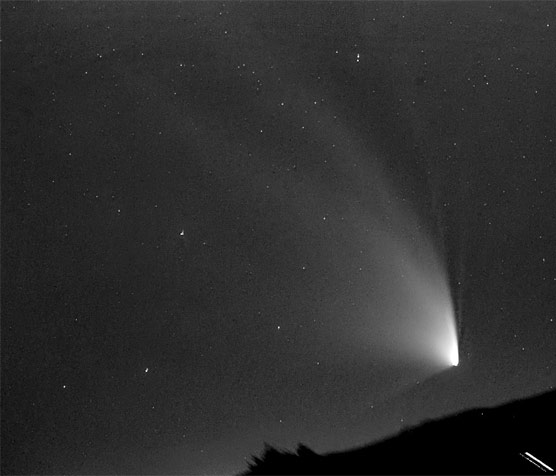
There's more to the tail than meets the eye. In this image taken by Michael Jaeger in Austria, skyglow has been supressed and contrast enhanced. Click here for the full 6° by 4° frame. Michael Jaeger |
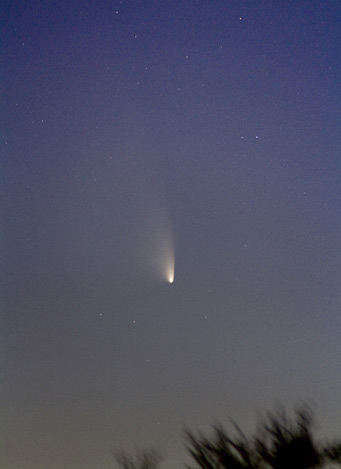
Comet PanSTARRS on March 17th. Earth's changing viewpoint toward its flat, thin dust tail is making the tail appear wider. Note the hint of a thin, straight ion (gas) tail just to the right of the curving dust tail's edge. Enhanced images show that it's real.
S&T: Sean Walker
March 18: Fading but higher. John Bortle writes, "I've been troubled for days regarding the broad range in reported magnitudes for this comet in recent days. Some ranked it near zero magnitude, while so many were indicating the comet was difficult or impossible to detect with the unaided eye.
Well, last evening [March 17th] I settled the matter as far as I am concerned. From careful observation I determined a total magnitude for the comet's head of only +2.6 , noting that even in a very clear sky the comet was only glimpsed with the unaided eye as twilight deepened. In my opinion the general lack of good comparison stars nearby has led to observers going far afield to stars much higher up for comparison, and then applying excessive atmospheric-extinction corrections to their estimates."
Many others disagree. Alan Whitman writes: "In my Canon 10x30 IS binoculars in excellent transparency, the nucleus was FAR brighter than adjacent magnitude 2.8 Gamma Pegasi. Magnitude 1 is a lot closer to its current magnitude, in my opinion."
Impressive time-lapse movie of PanSTARRS from the STEREO-B Sun-observing spacecraft, with coronal mass ejections passing by.
March 14: A little star with a dim tail. Many, many people saw it last evening, aided by the crescent Moon, but many others failed. S&T's Tony Flanders writes: "I caught it from the balcony of my mother's apartment at 7:55, 54 minutes after sunset [at latitude 41° N]. I'm sure I would have spotted it much, much earlier except that I had been looking too high, too far left, and for a very different kind of object.
"I'm sure this comet will never be obvious to the unaided eye from our latitude, much less spectacular. But it sure is a beauty through my 10x30 image-stabilized binoculars. I was looking for something larger and more diffuse; in fact, it's tiny and intensely bright, with a nearly stellar head (at 10x) and a short, very bright tail."
From S&T's Sean Walker at 43° N: "I was able to observe the comet with 70mm spotting scope and shared some great views with about 30 people. The comet was naked-eye visible, though barely, from about [50 minutes after sunset] until it was in the trees 15 minutes later.
"Not much of a tail, perhaps 1° with averted vision naked-eye. Never obvious; it was very reminiscent of the views we had in 2007 of Comet McNaught, though fainter. Still very orange due to low altitude.
"This photo by UK amateur Jamie Cooper approximates the view through a small telescope perfectly. It looked exactly like this in my 70mm f/5 spotting scope:"
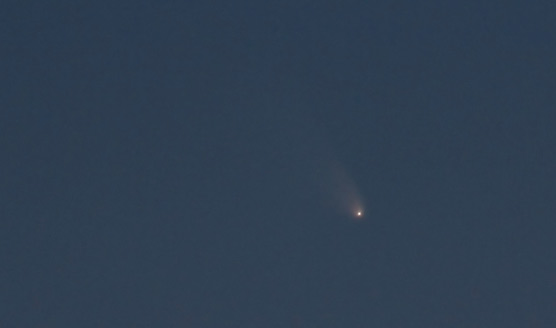
This view is about what to expect in a small, wide-field telescope. Copyright ©Jamie Cooper 2013. Lots more pictures. Jamie Cooper |
And from S&T editor Bob Naeye: "The comet was barely visible to the naked eye, and when I say 'barely,' I mean 'barely!' It was quite noticeable, however, in binocs. The coma was fairly bright and the tail was obvious. It was lovely through binocs.
"But I agree with Tony that this will never be a showstopper. Edwin, Imelda, and I pointed out the comet to several passersby, and they had a very, very difficult time seeing it naked-eye, and also had difficulty finding it through binocs. And yet they had the three of us standing right next to them explaining in detail where to look. We also had airplanes in the sky right near the comet, and we used the positions of those planes to help these passersby find the comet."
Tonight, March 14th, look about two fist-widths at arm's length below the crescent Moon and perhaps a bit right.
March 13: To the Moon! It's getting easier now; each evening the comet is a little less low in the twilight. Last night lots of photographers shot the little "smudge of light" with the thin crescent Moon:
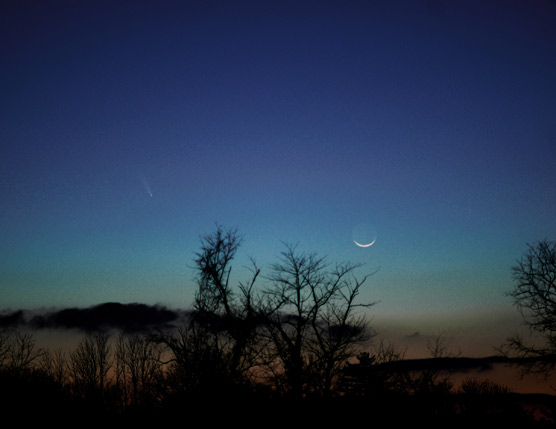
Greg Mort in Ashton, Maryland, was one of many who caught the comet and Moon on the evening of March 12th. He used a 100-mm lens and 2.5-second exposure. |
In tonight's twilight, look for the comet a fist-width at arm's length below the thicker Moon. Best view is roughly 40 minutes after sunset. You'll need an open view low due west.
Another nice Moon-and-comet pic from Fred Espenak, plus a movie of the two setting.
March 11: Speck, not spectacle. Last night lots of people in the north temperate latitudes finally began picking up the comet for the first time, but usually with binoculars, and only if they knew just where to look. Keep trying. It's moving a little higher out of the bright depths of twilight every day now.
This image matches a lot of people's visual impressions:
 58
58
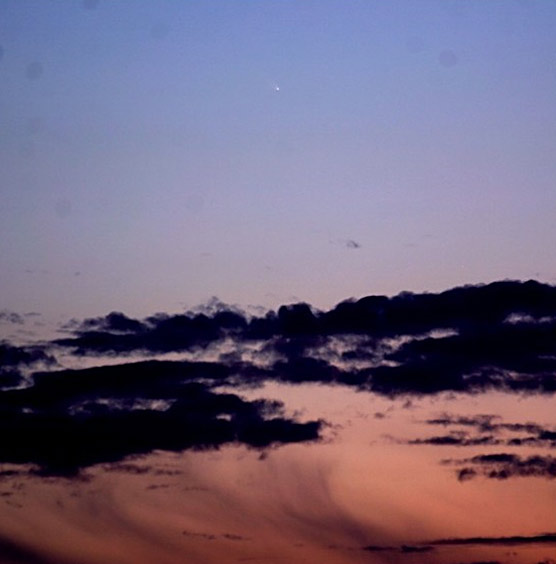
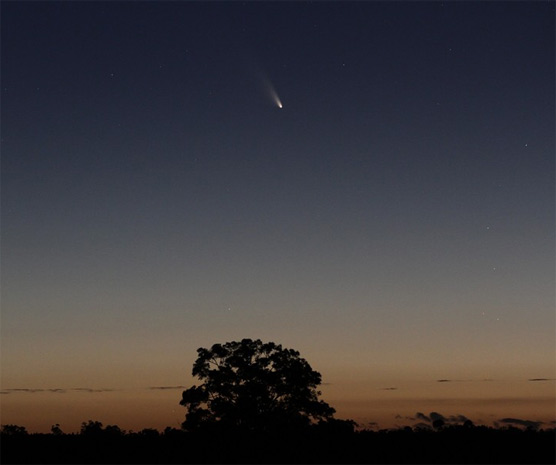
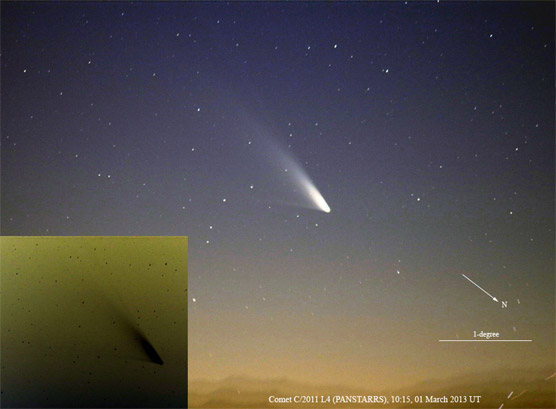

Comments
Jim Baughman
March 1, 2013 at 7:27 pm
I am in Los Angeles, just about 32 degrees north. A previous version of the detailed map included instructions for specifically adjusting the horizon due to variation from 40-degrees north. Could you publish that formula again?
You must be logged in to post a comment.
AzaelB
March 2, 2013 at 6:05 am
We were hoping to see the comet Panstarss just over the horizon after sunset by now, but the cloud cover conditions in Panama have deteriorated too much to be able to see anything and that includes the open sky. The cloud cover forecast indicates a reduction for March 5, when we will try a first look at it. The forecast does not show clear skies until March 8th, when the comet would be already visible in North America.
You must be logged in to post a comment.
jeff
March 3, 2013 at 7:27 pm
am excited to see the comet wonder if the Caribbean will be able to see it.
You must be logged in to post a comment.
[email protected]
March 4, 2013 at 1:35 am
Are we going to see comet panstarr in Africa if yes which parts of Africa.Are we going to see it with the naked eyes.
Which are the exact dates of veiwing it in Africa.
You must be logged in to post a comment.
Sara
March 4, 2013 at 9:07 pm
When can we see the comet from Anchorage Alaska??
You must be logged in to post a comment.
alsunni
March 5, 2013 at 11:10 am
I may be the first to spot Comet PanStarrs in northern
hemisphere Tuesday 5th from latidude 15+
KHARTOUM, SUDAN.
It was about 3 degrees above local horizon at about 7:25 PM
Local Time after sunset but it was faint to see details because of poor seeing it was 17 southwest of the sun and
I suggest its mag to be 1+.
You must be logged in to post a comment.
Rebecca S.
March 5, 2013 at 1:54 pm
Hoping to spot the comet tonight atop Haleakala volcano.
Will report.
You must be logged in to post a comment.
Rich Jones
March 5, 2013 at 5:56 pm
Tampa Bay Area Fla, USA, 27d55m Lat N; 82d42m Long W; Tues evening 05 March 2013 at 06:45 EST (11:45 UTC). Sky was crystal clear, local sunset at 06:32 EST. Observed Comet PanSTARRS in western sky with naked eye. Surprisingly bright. Approx 10d above twilight horizon. Great sight with 10x50 binoculars. Comet color appeared golden in the evening twilight conditions. Tail was well developed & Vee-shaped with bottom of Vee pointed toward sun. No problem seeing with naked eye even in bright twilight. Estimate 1st magnitude or brighter. Sky & tel location info a great assist, Thanks!!
You must be logged in to post a comment.
Rich
March 6, 2013 at 11:54 am
I wish that the "Punking out" article here would be deleted. I suspect that this comet will reach at least first magnitude, or six times brighter than the +3 in that article. Original predictions that I saw had this comet reaching 0.5, or hardly any different. A few models based upon early behavior had it attaining -1. Overalll, it has performed very creditably. Hopefully ISON will come this close to predictions in November/December. The main problem will be for newbie stargazers to pick it out of the bright twilight.
You must be logged in to post a comment.
Steve Weagle
March 6, 2013 at 4:14 pm
I received a few reports and photos last night from South Florida. I posted them on my Facebook page. I also notice a report above from the Tampa area. The photos seemed to indicate a fairly bright comet in the Florida twilight
Steve
[email protected]
Chief Meteorologist
WPTV/WFLX
You must be logged in to post a comment.
Ben Browning
March 6, 2013 at 6:46 pm
I was easily able to see PanSTARRS tonight from 33 degrees north latitude in eastern Alabama and western Georgia. It is 10-15 degrees left (south) of the sun after it sets and just a few degrees above the horizon. I only had a point-and-shoot camera with me at the time, but I did manage to capture a few pictures and posted them online at http://www.flickr.com/photos/benbrowning/sets/72157632937591972/.
You must be logged in to post a comment.
AzaelB
March 7, 2013 at 5:03 am
Weather is not collaborating very much in Central America. We were hoping to spot it among the first few. The Intertropical Convergence Zone front is approaching from the Atlantic and Africa to Northern South America rapidly and much cloud cover pushed by this front has prevented us in Panama to see or photograph it. However, as reports have shown, the Pacific coast of Mexico from Mazatlan to Huatulco should see it clearly, also the West coast of Florida from Pensacola to Ft Myers should be able to see, they have mostly clear skies until March 13. Congrats to people in FLA who have been able to spot it, it will be good to share those pictures. Out next trial to photograph it with my students and our telescopes will be Friday and Saturday. Good luck to all.
You must be logged in to post a comment.
Ben Browning
March 7, 2013 at 10:12 am
After some helpful critical comments on the images I took, it appears the tail direction is wrong and there's a bit of motion of the supposed comet relative to the background sky indicating what I actually photographed was probably distant contrails and not PanSTARRS. Sorry for the false alarm.
You must be logged in to post a comment.
Pat
March 8, 2013 at 9:13 am
In order to have a cloudless western horizon, how many miles to my west need to be clear?....I am trying to judge by satellite cloud cover photos/streaming how Far East of the cloud cover I need to drive for a clear western horizon? Thanks if anyone can help!
You must be logged in to post a comment.
Matt Lundy
March 8, 2013 at 1:15 pm
Obeserved C/2011 L4 from Denver,CO at about 1800 local time yesterday March 7th. Very bright, golden-yellow tail. Great view in binoculars. Set into the haze/mountains around 1820 local time.
You must be logged in to post a comment.
Rich Jones
March 8, 2013 at 7:50 pm
Update report from Tampa bay Fla.
Correctionn to 06 March report: refined measure indicates comet Approx, 3+° adove horizon; NOT 10° (over exuberant).
06 March, same location, local sunset 06:33pm EST, cold front had came thru, seeing on horizon excellant. Comet again visible, approx 4° above horizon. Tail now full, longer, pointed away from sun. Still goldish color thru twilight glow.
07 March, same location, local sunset 06:34pm EST, sea haze over gulf,degraded seeing, random pieces of cloud. Comet not viewed.
Appears sightings on 05 & 06 March were allowed by fortuitous horizon sky conditions. Seeing seldom that clear on horizon from an almost sea level viewing area.
You must be logged in to post a comment.
Stan Kerns
March 8, 2013 at 10:23 pm
No luck yet--but a list of set times would be nice so we could know when to pack it in.
Stan
You must be logged in to post a comment.
Rich
March 9, 2013 at 5:15 am
Could not spot it in some haze Thursday night at 38.5N, expected cloudy until Tuesday. Find a spot open all the way down to the western horizon. Note where the sun sets and start scanning slowly and carefully about 20-30 minutes later. A contrail will not gradually move down to the horizon like a comet does when it sets. Comet gone by about 45 minutes after sunset now from central U.S., gradually getting a little longer with each day. Tuesday night to the left of the moon and the next several days after that will probably be the best chance. Most good binoculars have a field of view about 5 or 6 degrees. Use the chart to estimate how high to scan half an hour after sunset, getting ever lower after that.
You must be logged in to post a comment.
Matt Lundy
March 9, 2013 at 1:59 pm
Grr I have to admit the possibility that my sighting was a contrail as well.
You must be logged in to post a comment.
Víctor R. Ruiz
March 9, 2013 at 5:48 pm
After some days of failures, today we spotted comet Panstarrs from Canary Islands (28° N, 1950 meters high). The conditions were not favorable due to cirrus. Around 19:45 UTC, the comet was visible during some minutes through holes in the clouds. It showed a bright nucleus and a small tail, quite nice to see through binoculars. It seemed brighter than magnitude 1, especially considering the atmospheric extinction, but not any near star was visible to compare. We took some photos, available at https://www.facebook.com/astrotemisas/posts/358008604312774
You must be logged in to post a comment.
Dan Duriscoe
March 10, 2013 at 11:49 am
From the White Mountains of California March 9 18:30 PST:
Found it with 92mm TMB refreactor at 22x, easy to see in telescope once located, impossible naked eye, very difficult 7x50 bincos. Right above the horizon of the peaks of the Sierra Nevada, estimate magnitude 1 allowing for extinction. In twilight with significant haze for this altitude (8000'), dust tail only about 1/4 degree seen. Very small but bright.
You must be logged in to post a comment.
Sam
March 10, 2013 at 10:33 pm
After a few days of trying, I finally spotted Comet PanSTARRS tonight from the San Diego coastline. It was tough to find in 7x35 binocs 45 minutes after sunset (1940PDT/0240UT), about 3 degrees above the horizon. Once found, it was much easier to come back to it. The live view screen of my camera provided much better contrast, where it was plainly evident. A couple photos here: https://s3.amazonaws.com/samsphotoshare/C2011L4.html
You must be logged in to post a comment.
Azael
March 11, 2013 at 7:37 am
After trying, more by chance than by more planning. Skies suddenly were clearing, next to the Panama Canal. We got a small 14 Mpixel camera, did not have the telescope on hand, so have the camera to take several pictures over tripod with sensitivity enhanced. Could not see it with naked eyes. So we stacked 8 pictures taken with same conditions, and there it was, at the right ascension and declination expected for the day/hour. Too dim, but it was there in the right spot. Could not see the tail, the center was just too dim. Another problem, since the picture was taken over the Panama Canal, there is a gas burning thermal plant nearby and they decided at the time to exhaust more gases than during the day. Could not take more pictures to stack. I will try tonight, March 11, with clearest skies than yesterday and a better location. This time I will setup everything on hand.
You must be logged in to post a comment.
[email protected]
March 11, 2013 at 8:48 am
SHALL WE BE IN POSITION TO SEE COMET PANSTARR IN
EAST AFRICA WITH OUR NAKED EYES
You must be logged in to post a comment.
alsunni
March 11, 2013 at 12:48 pm
I spotted comet PanSTARRS today (11 March) with its fuzzy
fan like tail , from Khartoum Sudan at about 7:40 pm local time . 40 minutes after sunset. (latidude 15 +) .
I used Binoculars 20X50 it appeared barely in the Binoculars like mag 4th star seen with unaided eye,
due to atmospheric extinction and light pollution of the city.
You must be logged in to post a comment.
alsunni
March 11, 2013 at 12:48 pm
I spotted comet PanSTARRS today (11 March) with its fuzzy
fan like tail , from Khartoum Sudan at about 7:40 pm local time . 40 minutes after sunset. (latidude 15 +) .
I used Binoculars 20X50 it appeared barely in the Binoculars like mag 4th star seen with unaided eye,
due to atmospheric extinction and light pollution of the city.
You must be logged in to post a comment.
Hamilton Davies
March 11, 2013 at 6:57 pm
Got a great view tonight at 8:09pm DST from Miami, Florida using Zhumell 20x80 binoculars.
You must be logged in to post a comment.
Fred
March 11, 2013 at 7:00 pm
We were able to see the comet with 15x70 binoculars and discern the classic comet shape from New Orleans, LA, for a good ten minute window from 30 to 40 minutes after sunset.
You must be logged in to post a comment.
Arnoldo Gomez Jr.
March 12, 2013 at 7:42 am
Last night March 11, 2013 i saw Panstarrs for thwe first time. I had been looking for it for three days. I saw it 45 minutes after sunset slightly SW of W. It was not a naked eye object for me last night, i could only see it through binoculars and when i tried with the naked eye i though i saw it but only with averted vision. Tonite it is going to be next to the moon, i hope i can see it without binos, i also plan to try to take some pictures of it. Will report back on tonites viewing.
You must be logged in to post a comment.
Ewell Schirmer
March 12, 2013 at 12:00 pm
Set up my 20x60 binoculars last evening with hopes of seeing PanSTARRS. As twilight faded and no comet I started looking at the Pleides, M42, Jupiter, and other objects. It was 8 pm or so, so decided to make one last effort to see the comet. My view is between the neighbors homes so I don't have a low horizon, but I watched the sunset and knew about where to start each search as I would scan N&S while increasing altidude..went to my starting postion and there it was..I had about 10 minutes before the comet would set below a distant roof. At 20X, I had a nice view..the northern streamer was definitely brighter, tail at most 2 degrees, magnitude (still in last vistages of twilight and glow of Dallas)was estimated at +1.5. Without knowing exactly where to look, I could barely discern the comet naked eye from my backyard. My limiting mag is around +4-4.5 in Plano, TX, a northern suburb of Dallas. Tonight, I may try to image it. [email protected]
You must be logged in to post a comment.
James Grose
March 12, 2013 at 9:13 pm
I was able to see Comet Pan-Starrs from within New Orleans without much difficulty with 10X50 binos. My first view of Pan-Starrs was last night from the Mississippi River levee here in the French Quarter. The comet was a challenge to pick up by unaided eye, but was quite easy thru my binoculars. The coma appeared quite bright, condensed, and star like which aided quite well in its visibility at least in binoculars. Viewed Comet Pan-Starrs again tonight, this time from the south shore of Lake Ponchartrain, paired up with the very thin hairline crescent moon. Plan to keep observing Comet Pan-Starrs as long as possible. Viewing Pan-Starrs is only an appetizer to Comet ISON toward the end of this year, provided the predictions for it pan out.
You must be logged in to post a comment.
AzaelB
March 12, 2013 at 9:57 pm
Update. The stacked photo taken on March 11 definitely the comet center, and not only that, the photo also showed Mars near the horizon and descending following the long gone Sun. Yesterday we tried again, more clouds right where there should be, no luck. We took some old fashion pictures with 1 to 5 min exposure, waiting to process the film to see it. Today was dissmal, no show, although the sky started to clear out, smoke coming from ships leaving the Panama Canal were covering the sight area. Tomorrow the forecast indicates clear skies over Central Panama, about three hours away from the capital. We will haul our equipment with some of my students to catch it for good. Good luck to all, it seems that Arizona, South of New Mexiso and Texas had clear skies.
You must be logged in to post a comment.
Philip Caputo
March 12, 2013 at 11:07 pm
Patagonia, AZ, U.S.A. Latitude 31d 32.5m north. We observed comet about 30 minutes after sunset (approx. 7pm local time), as the crescent moon was setting. Panstarrs was about 10 degrees above the SW horizon (elevated because of the mountains in Sonora, Mex.,), and angled slightly westward before falling from sight about 7:30 pm. I would guess a magnitude of 1.0, as it was visible to the naked eye, despite twilight glow. Through 15X70 binoculars, tripod mounted, it appeared to be the size of a golf ball, was colored pale orange (deepening as it drew nearer the horizon), and had a white, distinct tail resembling a horse's tail, tapered at the comet end, spreading out into nebulous strands at the other end. A grand sight at moonset here in the high desert.
You must be logged in to post a comment.
NS
March 12, 2013 at 11:40 pm
Spotted the comet tonight from my townhome west of Honolulu. Official sunset here was at 6:40 PM Hawaii time. Saw the comet around 7 PM to the left of the thin crescent moon. Initially I had to use my Orion StarBlast 6" (rich field) telescope to pick it out of a light hazy sky. 10 - 15 minutes later I was able to see it clearly with 8X42 binoculars. Bright head with a faint fan-like tail sticking more or less straight up from the horizon. It finally sank out of sight behind the Waianae mountain range at 7:28 PM.
You must be logged in to post a comment.
Jerry
March 13, 2013 at 6:10 am
Along the Columbia River, with the Cascades Mtns. to the west and clouds just above those through our opportunity window was virtually non-existent last evening (Mar 12). And true we couldn't see the comet with binoculars, but settled for photographing the 31 hour old moon against the landscape. Close inspection of the photos revealed a very faint glow with a short tail to the left of the moon.
You must be logged in to post a comment.
John Franch
March 13, 2013 at 9:03 pm
S&T editors had it right when they described Comet PanSTARRS as a "speck, not spectacle." I observed the comet tonight from Central Illinois for about 15 minutes beginning at approximately 7:35 p.m. C.D.T. Through 7X35 binoculars it looked like a slightly elongated, blurry "star" between 1.5 and 2 in magnitude. I doubt that very many non-amateur astronomers (especially those living in cities) will be able to discern this relatively inconspicuous "speck" in the bright evening twilight. Kudos to S&T for keeping it real.
You must be logged in to post a comment.
Azael
March 13, 2013 at 11:35 pm
Confirming sight of PanStarrs from Panama. Location: 8° 19.87' N, 80° 31.83' W. It was easier this time because it was located almost midway between the crescent Moon and the Sunset point at 7:00pm EST, along the ecliptic. We have some trouble with a long low cloud covering the view, so we waited for the comet to leave the lower part of the cloud. And there it was. We followed from 19:10 to 19:20 EST, as it got dimmer. Clearly saw the center spot and a short fan-out tail, visible over a brown-ochre background. It occupied about 1/10 of our field of view. We used a Celestron Powerseeker 114mm EQ reflector telescope (f/8.0) with a 15mm Kellner eyepiece with the help of a modified Celestron motor drive. We could not get a decent picture, we had a converted lifecam h3000 webcam and a digital camera with an eyepiece adapter, but it was just too low light to trigger the cameras. We also had an old film camera but did not have an adapter for the telescope. But anyway, my wife and I were extremely happy to see it for the first time. By the way we have to go a cow field in the country side of Panama near a colonial town to see it. Seven cows were our witnesses! We used Cartes du Ceil and Stellarium to help us find it. I wish luck to all who tried to see it.
You must be logged in to post a comment.
greg
March 14, 2013 at 10:57 am
After all the talk of PANSTARRS being a "dud", I was surprised how easy it was to find on the evening of the 13th about 40 minutes after sunset, from a residential street in the center of light-polluted DC. Although I couldn't see it with the naked eye, it was obvious as soon as I held up my 7x50 binocs. It had a sharp bright core, and a longer tail than I expected, probably only half a degree.
It's not Hyakutake, but it's easy to find and quite lovely. I was expecting little more than a dim blob, but I saw a pretty little comet. Very impressive!
You must be logged in to post a comment.
Dave Mitsky
March 14, 2013 at 12:53 pm
I was at a location with an excellent western horizon on Tuesday evening but had no luck detecting Comet C/2011 L4 (PanSTARRS) through a rather small break in an otherwise overcast sky. There was no chance at all of seeing it the previous two days, due to the weather.
My sister's birthday was on Wednesday. After having dinner at her and her husband's house, I drove about a mile to a spot with a good western horizon. I wasn't too optimistic about seeing the comet but there were some large holes in the clouds to the west and eventually I could see the young crescent Moon. I scanned downwards to the right with Celestron Ultima 10x50s and, lo and behold, about one-third of the distance between the horizon and the Moon I caught sight of a fuzzy star-like point of light. As the sky grew darker, I could make out the small tail of Comet PanSTARRS. My Burgess 15x70s produced a much better view. The coma was rather bright but I could not see the comet with my unaided eyes.
A line of low clouds obscured the comet so I called my wife to let her know that I'd been successful. I also called one of my observing buddies who lives about an hour to the north and was told that the sky was completely cloudy there.
After a few minutes the comet emerged from the clouds. It played peek-a-boo once again as more clouds crossed its path a bit later. Eventually it disappeared into the haze.
I was able to observe Comet PanSTARRS off and on until about 8:20 p.m. EST. I saw the comet for a total of about 25 minutes. When I got back to the party, I had a piece of cake and some ice cream to celebrate.
I probably wouldn't have been able to see the comet at all had I not gone southward for my sister's birthday party.
You must be logged in to post a comment.
John Tudek
March 14, 2013 at 7:08 pm
Saw it this evening (Mar 14th) about 30 mins after sunset. This was the first reasonably clear night we've had in almost two weeks. Still, the sky was hazy. Comet was too dim to be seen with the naked eye and faint but distinct in Orion Sceni 10x50 binocs. Great in a low power wide-field telescope view. Pic of the sighting can be found here: http://www.flickr.com/photos/hewhocaves/8557740053
You must be logged in to post a comment.
Richard F.
March 14, 2013 at 8:39 pm
Tonight was first night in several that I was able to spend any real time looking. I found comet fairly quickly with binocs, lost it while trying with naked eye, eventually located it again with binocs. Definitely naked eye visible by that point (around 8:00 MDT, or around 50 minutes after sunset).
You must be logged in to post a comment.
Gwendalynn
March 15, 2013 at 3:24 am
From Maui we were able to see the comet at sundown and saw the tail as well. After the sun went compleatly down it was no longer visable. It was below the moon seen from the Westside of Maui in Lahaina. Viewing it looking toward Lanai it was below and to the south of the moon. It was a beautiful sight and clouds just happened to be dissapating for us to view it with telescope. Beautiful.
You must be logged in to post a comment.
Albert
March 15, 2013 at 10:44 am
Evening of the 14th was not productive here in South Georgia. Skys over Sumter county were hazy in the west. Then, as twilight dimmed to the level that we could see the comet on recent nights, a large plume of moist cloudy air began to intrude directky into the area where we were searching. By the time of best viewing last night (between 8:20 to 8:50 pm) the whole lower western sky was clouded beyond any chance of visual contact.
You must be logged in to post a comment.
Dan
March 15, 2013 at 9:26 pm
Took half a chance and went out right on time on the 12th. No luck ay first. Then using the map and binocs I had a decent view. As at it darker I moved to my back yard and even grabbed picture. Then tonight fighting on shore clouds I caught it again. Seemed brighter then into the clouds. This from Hemet, Ca. Pic posted tonight. I'm no professional.
You must be logged in to post a comment.
Albert & Nancy
March 16, 2013 at 8:18 am
Evening viewing on the 15th was better than the 14th. Sky was much clearer, although we are still appalled at the low elevation obstructions to viewing from dust, smoke, etc. Albert did not see the comet for certain last night, but careful binocular work by Nancy allowed her to locate it twice before it set. This contact was made knowing exactly where we had looked on the previous nights. We doubt anyone could find it now if they did not have a reference from earlier nights work. (All our viewing was from an open knoll in a cotton field with an irrigation boom about 100 yards out from the viewing point, which provided a great reference tool to restart each night.) The interval between twilight obstruction and setting is now very small. Her sightings Friday night were between 8:30 and 8:45 pm. The comet was so faint that we could not see it over atmospheric conditions at all with the naked eye. The image seemed to come and go behind atmospheric conditions we could not even detect. Will be surprised it can be found at all tonight. All of our posted observations have been from a single location of approximately 31 deg. 57’ 0” North by 83 deg. 57’ 0” West.
You must be logged in to post a comment.
John Caruso
March 16, 2013 at 7:59 pm
Challenged myself to find this comet in the western sky over Temecula, CA. Went to a new library lot and parked; used a Sky Scout to locate Algenib, which I knew from maps the comet would be near. After scanning the sky with 10 x 50 binoculars I finally saw it --- pictures do not do it justice! I have seen many of the brightest comets during the last 35 years, but this one was absolutely amazing! Very bright relatively large fireball with a highly visible upward-sweeping tail; it could be compared to a sparkler of sorts. Have to comment that this comet is one of the best I have seen --- definitely worth the search! I have read other descriptions and maybe it is because it is so near the horizon at dusk, but this comet is awesome; even for the few minutes I got to see it before the clouds closed in, very impressive. I will follow this one every chance I get.
You must be logged in to post a comment.
[email protected]
March 17, 2013 at 6:18 pm
Got another good look at Comet Panstarrs tonight. It was much lower on the horizon than a week ago. The head was several magnitudes brighter this time and the tail a bit more luminous. It was an easily visible naked eye object at 7:50 PM but only the head was visible. I'm at latitude 44.30 degrees and had good visibility tonight
You must be logged in to post a comment.
carlos
March 18, 2013 at 12:17 pm
dear friends of sky&telescope.
it is posible to see the comet panstarrs L4 without the tail?
thx in advance
You must be logged in to post a comment.
Matt Lundy
March 18, 2013 at 1:31 pm
It seems that morning observations will be possible towards the end of this month?
You must be logged in to post a comment.
Dave Mitsky
March 19, 2013 at 12:45 pm
Last Thursday evening was rather cold and quite windy but six fellow Astronomical Society of Harrisburg members and I braved the conditions to view C/2011 L4 (PanSTARRS) from the ASH Naylor Observatory - http://www.astrohbg.org/ASH-i/Naylor_Observatory_info.html - near Lewisberry, Pennsylvania. I’d seen this visitor from the Oort Cloud for about 25 minutes the previous evening from another location through Celestron 10x50 and Burgess Optical 15x70 binoculars. On Thursday, I was able to observe the comet for about three-quarters of an hour through three Celestron binoculars (8x42s, 10x50s, and 15x70s), three refractors (an 80mm iOptron achromat, my 101mm Tele Vue TV-101 apochromat, and the 5" finder scope for the 17” classical Cassegrain), an 8" Meade LX90ACF SCT, and the observatory’s 17" classical Cassegrain.
The young owner of the iOptron refractor and the Meade SCT was able to locate Comet PanSTARRS with both go-to telescopes about 10 minutes before anyone was able to spot it with binoculars. He also captured images of the comet with a 300mm zoom lens and a Canon XTi DSLR camera that was piggybacked on top of his 8" SCT. I never saw the comet naked-eye but he did.
Comet PanSTARRS sported a short, curving dust tail. I wasn’t able to detect the weak ion tail visually. Its coma was a bright, star-like point.
The comet was fairly impressive through the 17” at 162x (40mm University Optics MK-70). It was quite low in the sky by then and had acquired a pale orange hue as a result.
I caught my last view of Comet PanSTARRS through the 8” SCT around 8:30 p.m. EST. By then, it was only a bit more than one degree above the horizon.
I also observed the crescent Moon, M41, M42 and the Sword of Orion, M44, and M45 that evening using my 101mm TV-101 refractor and a 14mm Explore Scientific 82 degree eyepiece (38x) and Jupiter at 162 and 216x using the 17" classical Cassegrain.
You must be logged in to post a comment.
Dave Mitsky
March 20, 2013 at 6:54 pm
I was able to observe Comet PanSTARRS again on Tuesday evening from the ASH Naylor Observatory using 7x50 and 15x70 binoculars, a 5" f/5 achromatic refractor, and a 17" f/15 classical Cassegrain at 118 and 162x. The comet was positioned farther to the west and seemed to be noticeably fainter than on March the 14th.
You must be logged in to post a comment.
Gordon Hommes
March 20, 2013 at 8:30 pm
On 16 March I was able to quickly sweep up Comet PANSTARRS with 10X50 binoculars from Duluth, Minnesota, while it was less than ten degrees above the western horizon. Seeing was very good through the cold arctic air mass typical of this region in winter, and the comet was visible to the naked eye without too much difficulty, despite the fairly bright twilight.
Although estimating the comet's brightness under such conditions is difficult, I believe the recent estimates of around magnitude zero, or a bit fainter, are about right.
You must be logged in to post a comment.
John Franch
March 20, 2013 at 9:09 pm
After a week-long gap, Comet PanSTARRS was observed again tonight from a bitterly cold central Illinois. Through 7X35 binoculars the coma appeared a bit larger and more diffuse and the fan-shaped tail more prominent though still quite short. Visually, the object barely gives a hint of its true glory as revealed by photographs. Intrigued by the raging magnitude controversy, I used the Sidgwick method (in-focus comet/out-of-focus star) to roughly estimate the comet's brightness and came up with a magnitude of 2.0, with Alpheratz as the comparison star. Comet PanSTARRS may not be a dud on the order of a Kohoutek but it certainly isn't a show-stopper like Hale-Bopp or Hyakutake.
You must be logged in to post a comment.
Bill Simpson
March 21, 2013 at 8:50 am
I could still see it quite well using 14X100mm Orion binoculars from the depopulated NASA Stennis Space Center acoustic easement in southwest Mississippi on the 20th. With such large lenses, the tail is easily visible even though the sky is still somewhat illuminated, even at 8:15 P.M. By the time it is really dark, the comet is so low in the sky from here at 30 degrees, that I am looking through many miles of dirty air that dims the comet. I can no longer see it without binoculars, but could on the 12th.
You must be logged in to post a comment.
Rick Scofield
March 21, 2013 at 11:42 am
I have had a great look at Punster for the last 3 nights, (March 18, 19, 20) here in Nebraska starting around 8:15 pm. I was unable to see it without the help of a pair of binoculars. Thanks to Sky and Telescope for the guidance.
You must be logged in to post a comment.
Rick Scofield
March 21, 2013 at 1:11 pm
Using the Correct name this time:
I have had a great look at PANSTARRS for the last 3 nights, (March 18, 19, 20) from Eastern Nebraska starting around 8:15 pm central time. I was unable to find it without the help of a pair of binoculars 25x100.
Thanks to Sky and Telescope for the guidance.
You must be logged in to post a comment.
Dave Mitsky
March 25, 2013 at 12:20 pm
I got skunked on Friday evening, March 22nd, due to low clouds (I was inside the administration building when the bolide - http://www.space.com/20360-east-coast-m ... eball.html - blazed across the sky so I missed that too), but I had success in observing Comet PanSTARRS once more from the Naylor Observatory on Saturday evening.
I was able to sweep the comet up in the western sky around 8:15 p.m. EDT (0:15 UT) with my 8x42s and then with my 15x70s.
Next I placed a 35mm Explore Scientific 70 degree eyepiece in the 5" f/5 finder scope (18x) and, using the 15x70s, the Telrad, and trees in the distance as landmarks, located the fading comet. I replaced the 35mm with a 14mm Explore Scientific 82 degree eyepiece and got a good look at its central condensation at 45x.
The 17" f/15 classical Cassegrain produced fine views at 118, 162, and 185x, with 162x yielding the best view. The central condensation was bright and the dust tail seemed to be wider and less uniform than on last Tuesday.
I made a rough sketch and tracked Comet PanSTARRS for about five minutes after it went below the western treeline. I could see a wisp of the comet through the tree limbs until 8:48 p.m. EDT (0:48 UT). The Argo Navis altitude-azimuth reading at the time was approximately 16 degrees and 288 degrees but I'm unsure how accurate that was.
You must be logged in to post a comment.
Jeff Sullivan
March 29, 2013 at 3:15 pm
I've caught PANSTARRS March 12 and 23 so far. Here's a time-lapse video with footage from those nights: http://www.youtube.com/watch?v=d5cgD1jp0S8
You must be logged in to post a comment.
You must be logged in to post a comment.